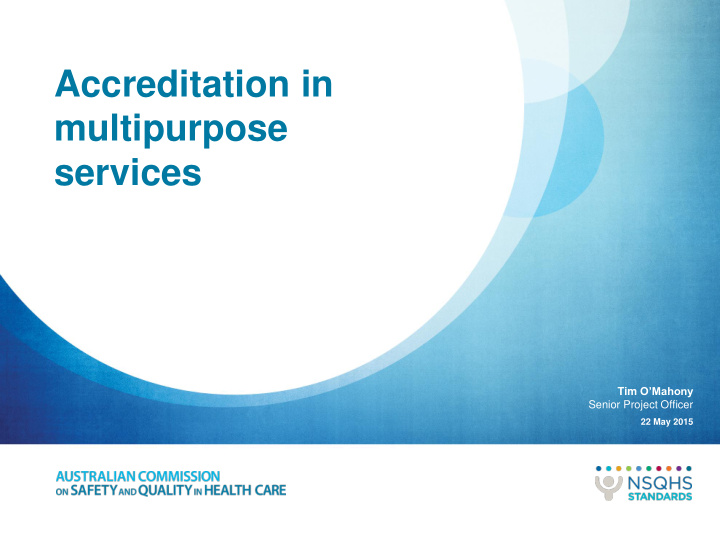



Accreditation in multipurpose services Tim O’Mahony Senior Project Officer 22 May 2015
Presentation outline • Current accreditation processes for multipurpose services • ACSQHC and NSW Health project • Future opportunities for accreditation in multipurpose services
Current accreditation for multipurpose services • The NSQHS Standards are mandatory for acute and sub-acute sections of multipurpose services • The residential aged care accreditation standards are mandatory for residential aged care facilities • Neither set of standards are mandatory for aged care provided in multipurpose services • WA Health pilot incorporates Accreditation Standards and Home Care Standards, although not NSQHS Standards.
ACSQHC and NSW Health project • NSW Health funded project • ACSQHC: • Mapped both sets of standards • Consulted with 70+ multipurpose service staff around gaps and risks (survey, workshop and interviews) • Proposed changes to the accreditation process
National Safety and Quality Health Service (NSQHS) Standards Standard 2 Standard 1 Partnering with Governance for Safety and Consumers Quality in Health Service Organisations Standard 3 Standard 10 Healthcare Preventing Falls and Associated Harm from Falls Infections Standard 4 Standard 9 Medication Recognising and Safety Responding to Clinical Deterioration in Acute Health Care Standard 5 Standard 8 Patient Identification Preventing and and Procedure Managing Pressure Matching Injuries Standard 6 Standard 7 Clinical Blood and Blood Handover Products
Residential aged care Accreditation Standards • Standard one: Management systems, staffing and organisational development • Standard two: Health and personal care • Standard three: Care recipient lifestyle • Standard four: Physical environment and safe systems
Introduction to mapping and reverse mapping Accreditation NSQHS Standards Standards
Introduction to mapping and reverse mapping Accreditation NSQHS Standards Standards
Introduction to mapping and reverse mapping Accreditation NSQHS Standards Standards
Introduction to mapping and reverse mapping Accreditation NSQHS Standards Standards
Key findings • Accreditation seen as an important lever for safety and quality • However, staff engagement and workload demands are barriers to implementation of the NSQHS Standards • NSQHS Standards need modification for an aged care setting • Process vs. individual focus of standards
Key findings – relevance of NSQHS Standards (1= not relevant, 2= somewhat relevant, 3= relevant, 4= very relevant ) 3.86 4.00 3.81 3.76 3.63 3.53 3.45 3.50 3.21 3.03 3.00 3.00 2.50 2.19 2.00 1.50 1.00 0.50 0.00
Mapping - NSQHS Standards to Accreditation Standards • Standard 1: Governance for Safety and Quality in Health Service Organisations • Standard 2: Partnering with Consumers • Standard 3: Preventing and Controlling Healthcare Associated Infections • Standard 4: Medication Safety • Standard 5: Patient Identification and Procedure Matching • Standard 6: Clinical Handover • Standard 7: Blood and Blood Products • Standard 8: Preventing and Managing Pressure Injuries • Standard 9: Recognising and Responding to Clinical Deterioration in Acute Health Care • Standard 10: Preventing Falls and Harm from Falls
Mapping - Accreditation Standards to NSQHS Standards • Standard one: Management systems, staffing and organisational development • Standard two: Health and personal care • Standard three: Care recipient lifestyle • Standard four: Physical environment and safe systems
Gaps in the NSQHS Standards for aged care • Homelike environment and independence • Role of person in their own care (person centred) • Acute care focus • Cognitive impairment • Security of tenure • Referrals to external services • Nutrition and hydration
Recommendations • Implement the NSQHS Standards across multipurpose services, with exclusions for actions that are not applicable to this settings • Include elements from the Accreditation Standards as a set of ‘combined multipurpose service standards’ • Develop resources to support the combined standards • Align accreditation of multipurpose services • Include information from this project in the review of the NSQHS Standards
Review of the NSQHS Standards – Key milestones 2015 Drafting NSQHS Standards Version 2 (V2) Piloting and public consultation for NSQHS Standards V2 Re-approval of accrediting agencies 2016 Finalise and design of NSQHS Standards V2 Undertake regulation impact statement process Submit NSQHS Standards V2 to the Board, AHMAC and COAG Health Council Develop NSQHS Standards guides and tools Review Australian Health Service Safety And Quality Accreditation Scheme 2017 Deliver education and training for health service organisations and approved accrediting agencies Implement NSQHS Standards V2 2018 Ongoing support for health service organisations and accrediting agencies
Recommend
More recommend